A new whipstock-and-packer approach to drilling openhole laterals can reduce rig time and risk by eliminating the need to set cement.
Garry W. Templeton and Andre Broussard, Weatherford International Ltd.; and Deck Travis, Southwestern Energy Company
Southwestern Energy faced a real challenge drilling openhole laterals in pilot wells in central Arkansas’ Fayetteville Shale. The company’s wells were drilled vertically through all relevant formations, so any lateral into a producing zone had to be kicked off at some midpoint of the vertical open hole—but the nature of the shale formation made it very difficult to set a cement plug and drill off it.
A sidetrack approach using an openhole whipstock with an inflatable packer-anchor solved the problem. The approach essentially provides cased-hole lateral-drilling flexibility from vertical open holes, saving time and money and enabling more consistent sidetracking operations. First described in 2009, this system has now been implemented in 153 wells ranging from 1,500 to 11,000 ft, and in formations with compressive strengths from 1,000 to 65,000 psi.
The technology appears to have potential for openhole drilling, including sidetracking a well obstruction, correcting directional azimuth and targeting one or more pay zones uphole from the original well depth. There are no depth limitations and few temperature restrictions, as high-temperature packer elements enable operations at temperatures above 300°F. Using a retrievable packer makes it possible to drill multiple laterals in a single wellbore. Finally, a flow-control sub now being introduced will allow the system to be used with MWD in an extended horizontal multilateral; in combination with retrievable assemblies, the technology could simplify drilling of complex fishbone configurations.
Because the openhole whipstock with inflatable packer-anchor is based almost entirely on standard tools, it can potentially be employed in any type of open hole, including ultradeep offshore wells.
This article describes ongoing enhancements to the system and reviews lessons learned and the limitations of the approach, based on operational experience in the Fayetteville Shale of Arkansas and the Eagle Ford Shale and Olmos sandstone of South Texas.
THE INITIAL CHALLENGE
Traditional openhole sidetracking operations involve either time-drilling (i.e., with low ROP and low weight on bit) off a cement plug or drilling off a whipstock cemented in place. The first option can be costly in terms of mobilizing the cement unit, waiting for cement to set with the rig and rental equipment on standby (about 24 hr), dressing the cement plug to the kickoff point, and time-drilling off the plug (about 12 hr), Fig. 1. If the cement doesn’t have the necessary compressive strength, the plug may have to be drilled out and reset, restarting the clock. Drilling off a cemented whipstock is only slightly faster.
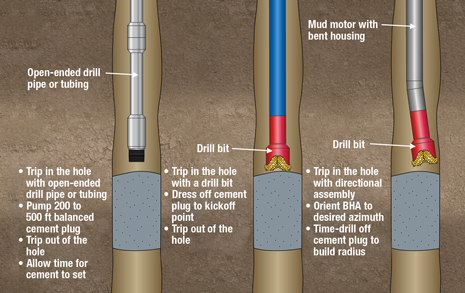 |
|
Fig. 1. Kicking off a cement plug.
|
|
In the past, cementation time has been accepted as a necessary evil. But the Fayetteville Shale in central Arkansas presented many additional issues: First, the cement plug had to be set in the open pilot hole without anything solid to rest upon; and second, the shale was sensitive to the water in the cement. The lightweight oil-based mud used for drilling wouldn’t support cement, and a viscous gel plug set beneath the cement could still allow it to slump into the hole and become contaminated and weakened by oil-based wellbore fluids. The flaky nature of the shale made hole cleaning difficult, and cuttings also weakened the cement. An additional problem appeared in the Eagle Ford Shale, where one oil company reported that CO2 influx honeycombed the cement to the point where it was nearly useless. Multiple plugs had to be set to enable a sidetrack in that formation.
Southwestern came to the problematic Fayetteville Shale in 2005 with a 15-year gas recovery maximization project. The company initially planned to drill six to eight wells per 640-acre land section, with a planned spacing between wells of about 600 ft, depending on surface obstructions and faulting in the production interval. As production has commenced, the number of wells has been expanded exponentially to take advantage of the fact that there is almost no interference between producers placed at very narrow intervals.
About one in six wells is a pilot well drilled through the formation and logged to locate the pay interval. After logging is complete, a lateral is drilled into the pay zone, which might be as much as 1,500 ft above the bottomhole depth of the pilot. The first laterals were 2,000 ft long, but laterals currently extend as far as 8,000 ft.
For the first 26 pilot wells drilled, Southwestern’s costs for the sidetracking cementation averaged about $350,000 per well. This cost includes time for running tubing or drill pipe to the plug depth, conditioning the hole and pumping the cement plug, waiting for the cement to set up, tripping and dressing off the plug, and drilling off the plug with a directional drilling assembly. The associated costs include rig spread rate, cost of cement and cementing equipment, cement pump rental, tubing rental and disposal of waste fluids. With an ultimate potential for 3,000–4,000 pilot wells in the field, Southwestern needed to find a better way.
A NEW SIDETRACKING APPROACH
Weatherford approached Southwestern with the idea of eliminating cementation by using an openhole whipstock with an inflatable packer-anchor. The system could be run in a single trip to create the kind of lateral shown in Fig. 2.
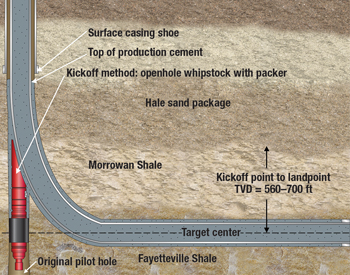 |
|
Fig. 2. A typical well schematic for the Southwestern project.
|
|
Most openhole whipstocks are cement-in-place whipstocks that include 30–60 ft of perforated pipe below the whipstock to anchor the assembly in the cement. As noted above, this type of whipstock is usually set on something solid, like a fish or the bottom of the well, but, in this case, there was nothing to set it on. The solution was to combine an openhole whipstock with an inflatable packer, eliminating the perforated pipe and the cement. The assembly would be designed to allow pressure to be conveyed through the workstring and whipstock and applied at the packer, and the inflating fluid would be the same fluid as was used to drill the well. The shale would never be exposed to water, and the sidetrack could be kicked off at any depth.
The tools used in the assembly would include (from the top down) a universal bottomhole orienting sub (UBHO), a setting tool attached via shear pin, the whipstock, the inflatable packer and a bull plug to close the system. Everything would be run in dry—no circulation—to the kickoff depth and then oriented using either gyro or electromagnetic MWD (EM MWD) if the hole was shallow enough. Drilling fluid would then be pumped through the setting tool and whipstock and into the inflatable packer. Once the packer was inflated, the drillstring would be lowered to shear the setting tool from the whipstock, after which the setting tool could be tripped out of the hole.
The well would thus be ready for sidetracking after a single trip and without waiting for cement to set. A directional drilling assembly run in to the top of the whipstock would be oriented to the same azimuth as the whipstock face and put to work building the lateral curve radius, Fig. 3.
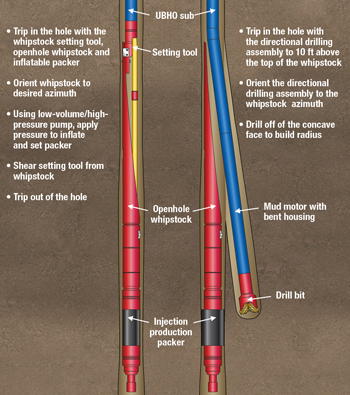 |
|
Fig. 3. Kicking off of a whipstock and inflatable packer-anchor assembly.
|
|
Southwestern agreed to the whipstock-packer approach and used it in 34 holes. The average sidetrack cost per well dropped to $170,000 from about $350,000—a savings of more than 50%. This total cost includes time to run the whipstock-packer-anchor assembly to setting depth, orient the assembly and drill off the whipstock, plus the associated costs of the whipstock, packer, pump rental and service operator.
Since its initial success in these 34 wells, the whipstock-packer approach has been used in 153 wells in the Fayetteville Shale, the Eagle Ford Shale and the Olmos sandstone.
MEETING REGULATORY REQUIREMENTS
Regulations require setting a cement plug over any zone that may produce hydrocarbons, so plugging formations in pilot holes is another challenge in shale.
Such a requirement by the Texas Railroad Commission exists in South Texas, where Swift Energy was exploring the Eagle Ford Shale. Swift had drilled pilot holes through the Olmos sandstone, about 1,500 ft above the Eagle Ford Shale, and was faced with plugging the Olmos, setting a whipstock and sidetracking down past the Olmos to reach the Eagle Ford producing zone.
The recommended solution for this was the whipstock-packer-anchor combination, but with a ball seat and several joints of 2⅜-in. or 2⅞-in. sacrificial (junk) tailpipe on the bottom of the packer instead of a bull plug, Fig. 4.
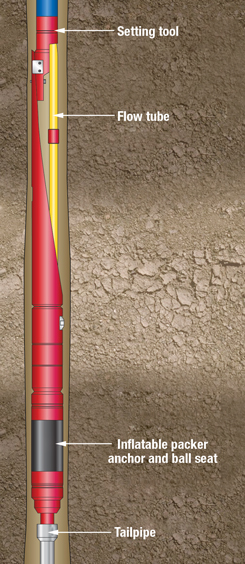 |
|
Fig. 4. The whipstock-packer-tailpipe configuration for plug and abandonment work.
|
|
The tool is open when run in so that cement can be circulated. At the proper depth, the assembly is oriented with gyro, after which cement is circulated out the bottom of the tailpipe until the column of cement rises in the annulus to the top of the tailpipe. A steel ball dropped from the surface locates into the ball seat and seals off the packer, which can then be inflated. The whipstock is now ready for directional drilling.
Multiple plugs can easily be set in the same hole. In this case, the packer is not set after the first cementation; instead, the entire assembly is pulled up to the depth for the next plug, and the cementation process is repeated. Because the tailpipe is small in diameter relative to the wellbore, the cement left behind when the tailpipe is pulled slumps into the hole and completes the seal. At any point, and after any number of plugs, the assembly can be oriented and the packer set, readying the whipstock for sidetrack operations.
To date, six of these jobs have been run, of which four have employed two plugs in the same well. The goal was to create an overall long cemented column so that heel fractures or gas-bearing zones close to the curve of the lateral would not communicate to the formation being plugged; for the first few jobs, a long column was created by placing two shorter columns close together. The first cement columns were 300 ft, followed by 600 ft. These operations proceeded flawlessly, and the next run for Swift is designed to place 950 ft of cement in a single step.
In one case, Swift used the tailpipe approach to plug off a shallow gas zone below the lateral kickoff point. The whipstock/inflatable-anchor/tailpipe assembly was run into the gas zone, the zone was isolated with cement, and the assembly was lifted up to the kickoff point. Then the inflatable packer-anchor was set, and the lateral was drilled without incident.
In another situation, Southwestern ran a whipstock below a whipstock. An early pilot well had been sitting for a year or two, and when the company returned to re-enter the hole and drill a lateral, the hole was in bad shape. A whipstock-packer-anchor assembly was set above the damage and sidetracked down past it. The well was logged, after which a second whipstock-packer-anchor assembly was set below the first. The second assembly easily cleared the first during run-in, and the operation proceeded without problems. Once the lateral was drilled, the hole was cemented past both whipstocks, and the lateral became a producing well. Southwestern is now investigating use of the whipstock-packer-anchor assembly for multiple laterals in the same pilot hole.
Another interesting problem solved by the whipstock-packer-anchor system occurred in the Barnett Shale. An oil company operating there discovered that the cementing operation stripped filtercake from the wall of the well, after which the shale became water-wet and fell in. This company lost holes until it switched to the whipstock-packer system, which, it reports, has reduced both risk and rig time.
To date, 29 companies have used the whipstock-packer-anchor technology in the US, and clients in the Middle East and South America have expressed interest.
RETRIEVABILITY, AUTO-FILL AND MWD
Retrievability opens additional opportunities, and a retrievable whipstock-packer assembly has been tested and is now ready for field deployment. A shearing mechanism on this packer makes it possible to run in, inflate the packer, shear off, drill the lateral, then run in again to grab the whipstock and packer, deflate the packer, pull it out, and gain access to other laterals. The laterals could be part of a multilateral openhole completion or fishbones in an extended-reach horizontal well.
Another new enhancement is an auto-fill sub. It is open to the annulus, allowing the drillstring to fill while being run in the hole. Once on depth, the MWD operating circulation flowrates are established and the whipstock is oriented to the desired heading. Then the flowrate is increased, creating an increased pressure drop to inflate the packer. (In the current approach, the packer is sealed before being run in, leaving the pipe dry.) The automatic fill sub could save hours of rig time now spent filling pipe prior to inflating the injection production packer (IPP) anchor.
The auto-fill concept led to the idea of creating a whipstock-packer system that would allow circulation while being run, so that the whipstock could be set and oriented using standard mud-pulse MWD instead of using gyro or EM MWD. The mechanism for this is a flow-control sub, which has been developed and tested and is currently being manufactured.
The complete MWD assembly will include the standard bull plug at the bottom, then the packer-anchor, the whipstock and setting device, the new flow-control sub with a port to provide mud flow from the workstring to the annulus, and the MWD tools at the top. While running in and orienting, the flow-control sub will allow enough flow to operate the MWD. Once orientation is achieved, a pressure increase will alter the device to halt flow and inflate the packer. The drillstring will then be lowered to shear the setting tool and the flow-control sub and allow them to be pulled out.
LESSONS LEARNED
Success rates and efficiency in using the whipstock-packer-anchor method for sidetracking have improved dramatically as lessons were learned.
Packer selection and setting. The first efforts with the whipstock-packer approach employed the discontinuous-rib version of the inflatable annulus casing packer (ACP). This is a mature oilfield technology that is relatively simple to operate; it seemed that the discontinuous-rib design would be suitable for varying openhole gauge conditions. Unfortunately, in six of the 11 attempts with the ACP (eight wells), this packer was not successful in anchoring the whipstock.
The fatal disadvantage of the ACP was that the final setting pressure had to be determined and set before running into the well. This limited the ability to control anchoring forces when there were inconsistencies in openhole geometries or formation stabilities.
In place of the ACP, another field-proven, mature technology used in well stimulation and production testing applications was substituted—the IPP. This type of packer features a one-way hydraulic inflation valve that allows inflation pressure to be increased as necessary. Its steel-cable-reinforced element also accommodates varying openhole geometries, and the shorter element limits exposure to damage when running in open hole.
There were two issues to resolve with setting the packer. First, fluctuations and high-volume flowrates in conventional rig pumps made these pumps unreliable. Using low-volume, high-pressure pumps, such as cement pumps, solved the problem. The second issue was refining the setting and pressure-testing procedure to ensure that the packer valve was set. Once this procedural change was made, there were no instances of packers failing to set or remain seated in the wellbore.
In a few cases, packers have been pushed downhole due to rough treatment from the surface after the lateral was drilled. Since all holes are mapped, the lateral could be reentered easily.
In regaining access into the lateral, a full joint of pipe is used to connect the whipstock to the packer rather than to the standard 6-ft crossover sub. This procedure helps ensure that the second packer sits in an undamaged part of the hole.
Four-arm vs. two-arm caliper. Running a caliper log is an important step before any sidetrack. Washout areas can adversely affect the setting strength and holding force of the packer, and they can also force the top of the whipstock away from the wellbore wall, which creates an obstruction that leads to bit damage. Experience indicates that any washout more than 2 in. larger than the drilled diameter of the wellbore renders the whipstock-packer approach inadvisable.
Another potential wellbore problem is spiraling, which can result in the top of the whipstock sitting away from the wellbore wall. Spiraled sections should be avoided as kickoff points.
To correctly gauge the wellbore profile, a four-arm caliper should be used. It is a far better indicator of hole size and concentric configuration than a two-arm caliper.
Examples of washed-out and spiraled wellbore situations are shown in Fig. 5.
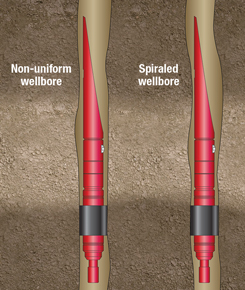 |
|
Fig. 5. Whipstock-and-packer assembly set in non-uniform sections.
|
|
Other issues. Testing indicates that the whipstock should be set to exit toward the high side, up to 70° left or right of the high side in hole sections where the inclination exceeds 3°. If the whipstock is set for a low-side exit, it could sag under its own weight, causing the whipstock’s tip to fall away from the wellbore wall.
The length of the pup joint between the whipstock and the packer can be critical: too long, and there is enough flexibility in the system to allow the whipstock to obstruct the drill bit; too short, and there is a danger of the drillbit nicking the side of the packer and deflating it while passing.
CONCLUSIONS
Overall, sidetracking has been successful in 149 of the 153 jobs recorded using IPP packer-anchors, a success rate exceeding 97%. Of the 149 sidetracks, 138 have been completed in a single trip, a success rate of 92%.
A total of 166 openhole whipstock assemblies have been run, since some jobs involved more than one assembly. Of these 166 assemblies, 17 were unsuccessful. Ten of them failed because of operational issues and seven failed due to packer issues.
Of the 10 operational failures, five resulted from hole conditions (wellbore spiraling and washouts) that left the tip of the whipstock projecting into the hole instead of tight against the wall. In three cases, a second whipstock was set and the sidetrack was completed successfully. Seven runs of the IPP-packer have failed due to packer inflation issues.
Compared to the record for cementation, the current success rate for the whipstock-packer is remarkable. The whipstock-packer combination saves substantial rig time, decreases sidetracking costs and is substantially more reliable and less risky than the cement-plug method. The new technology gives cased-hole flexibility to openhole sidetracks. Particularly with the flow-control sub and MWD capability, it has potential for a very wide range of applications. 
ACKNOWLEDGMENTS
This article was prepared in part from SPE 123577 presented at the SPE Annual Technical Conference and Exhibition held in New Orleans, Oct. 4–7, 2009. The authors wish to thank the 29 companies that have participated in testing and proving the technology discussed.
|
THE AUTHORS
|
 |
Garry Templeton is the North American Technical Specialist for Weatherford Reentry Systems. He began his career in downhole oilfield applications in 1983, and joined Weatherford in 1996, specializing in fish and re-entry. Mr. Templeton is a member of the Society of Petroleum Engineers.
|
|
| |
Deck Travis is a Senior Staff Drilling Engineer with Southwestern Energy, currently working in the Fayetteville Shale. He joined Southwestern in 2001 working in East Texas and South Louisiana. Mr. Travis has more than 30 years of experience in drilling operations throughout various North American basins. A 1979 graduate of Oklahoma State University’s petroleum engineering program, he has held or participated in several patents on coring and cementing.
|
|
| |
Andre Broussard is Technical Specialist for Weatherford International Ltd. He holds a BS degree in mechanical engineering from Louisiana State University and an MBA from the University of Houston, Clear Lake.
|
|








